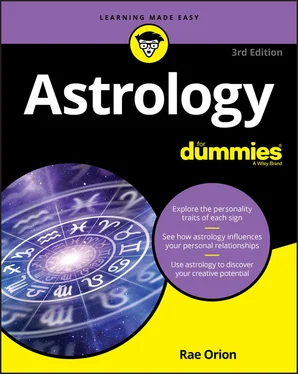 Introducing the rulers of each sign
Introducing the rulers of each sign
 Determining planetary dignities
Determining planetary dignities
 Discovering the Ascendant
Discovering the Ascendant
 Wandering through the houses
Wandering through the houses
Legend has it that Sir Isaac Newton, one of the greatest scientific geniuses of all time, may have been interested in astrology. Newton had a complex, wide-ranging mind. In addition to inventing calculus, formulating the laws of motion, and discovering the universal law of gravity, he wrote Biblical commentary and speculated about possible dates for the end of the world (all, by the way, in our current century). He experimented with the alchemical quest to turn ordinary metals into gold and may have suffered from mercury poisoning as a result. And he was interested in astrology, claiming that a book he read on the subject while a student at Cambridge University had ignited his interest in science. When his friend Edmund Halley, after whom the comet is named, made a disparaging remark about astrology, Newton, a conservative Capricorn, shot right back, “Sir, I have studied the subject. You have not.” Or so the story goes.
Like every other astrologer, I like to think that story might be true. After all, astrology has faded in and out of fashion, but it has never lacked followers. Twenty-five hundred years ago, Babylonian astrologers were casting individual horoscopes. The Romans consulted astrologers regularly. Emperor Augustus visited an astrologer in 44 BCE, the year Julius Caesar was assassinated, and the orator Cicero, who spoke vehemently against astrology, numbered several well-known practitioners among his friends. In the eighth century, Charlemagne studied astrology under the auspices of an English monk. Catherine de Medici consulted Nostradamus, Queen Elizabeth I sought counsel from the astrologer John Dee, and other astrologers advised Richard the Lion-heart, Napoleon, George Washington, J. P. Morgan, and Ronald Reagan. Yet in all that time, no one has provided a satisfying explanation of why astrology works. Over the centuries, proponents of the ancient art have suggested that gravity must be the motor of astrology … or electromagnetism … or the metaphysical “law of correspondences.” Carl G. Jung summarized that view when he wrote, “We are born at a given moment, in a given place, and like vintage years of wine, we have the qualities of the year and of the season in which we are born.”
I don’t know why astrology works any more than Sir Isaac did. I do know that the pattern the planets made when you were born — your birth chart or horoscope — describes your abilities, your challenges, and your potential. It doesn’t predict your fate, though it does make some fates more easily achievable than others. The exact shape of your destiny, I believe, is up to you.
In this chapter, I give you an overview of the main components of an astrological chart: the planets, the signs, and the houses. You might think of it this way:
The planets represent drives, needs, and basic energies.
The signs represent the ways those forces express themselves.
And the houses represent areas of life such as career, partnership, sex, money, and health.
Looking at the Starry Sky
Picture, if you will, our solar system. In the middle is the Sun, our star. Spinning around it are the Earth and other planets along with countless asteroids, planetoids, comets, and a few lonely spacecraft. Their orbits surround the Sun roughly the way the grooves on a vinyl record album encircle the label in the center. (Although, to be clear, the orbits are not perfectly circular, and the solar system, unlike the record, is not perfectly flat.)
The idea that the planets orbit the Sun, drilled into most of us in childhood, would have astonished ancient stargazers. They never doubted that the Sun, the Moon, and the planets revolved around the Earth. And although we know better, thinking so didn’t make them stupid. The Moon does revolve around the Earth — they weren’t wrong there — and the Sun certainly looks as if it does. It appears to rise in the east and set in the west, and it always travels along a narrow ribbon of sky that surrounds the Earth like a giant hoop. That pathway is called the ecliptic . It maps the annual journey of the Sun.
 Following are the most important facts about the ecliptic:
Following are the most important facts about the ecliptic:
The ecliptic represents the apparent path of the Sun around the Earth — apparent because, in reality, the Sun doesn’t spin around the Earth at all. It just looks that way. The Moon and the planets seem to travel a similar path, wandering a little to the north and a little to the south of the Sun but basically following the same route.
Like a circle, the ecliptic has 360 degrees. Those 360 degrees, divided into a dozen equal sections, comprise the signs of the zodiac. The first 30 degrees — one-twelfth of the whole — are given to Aries, the next 30 degrees belong to Taurus, and so on. Each sign receives the same amount of space.
The stars, which are scattered like dust along the ecliptic, form the constellations of the zodiac. They are the background, a sort of celestial wallpaper against which the Sun, the Moon, and the planets move.
 Here comes the confusing part: The signs of the zodiac and the constellations that share their names are not the same. The signs are geometric divisions of the ecliptic, each one covering 30 degrees, each one precisely the same size. In contrast, the constellations vary in size from sprawling Virgo, the second largest constellation in the sky, to Capricorn, a faint collection of stars less than one third the size of Virgo. Although the signs of the zodiac take their names from the constellations, the signs and the stars have nothing to do with one another. I explain this sorry state of affairs in the nearby sidebar titled “The signs, the constellations, and the precession of the equinoxes.”
Here comes the confusing part: The signs of the zodiac and the constellations that share their names are not the same. The signs are geometric divisions of the ecliptic, each one covering 30 degrees, each one precisely the same size. In contrast, the constellations vary in size from sprawling Virgo, the second largest constellation in the sky, to Capricorn, a faint collection of stars less than one third the size of Virgo. Although the signs of the zodiac take their names from the constellations, the signs and the stars have nothing to do with one another. I explain this sorry state of affairs in the nearby sidebar titled “The signs, the constellations, and the precession of the equinoxes.”
THE SIGNS, THE CONSTELLATIONS, AND THE PRECESSION OF THE EQUINOXES
Thousands of years ago, when the Babylonians were establishing the principles of astrology, the constellations and the signs of the zodiac were roughly in alignment. On the vernal equinox (the first day of spring), the Sun was “in” the constellation Aries. That is, if you could observe the Sun and the stars simultaneously, you’d see the Sun amidst the stars of the Ram. In those happy days, known as the Age of Aries, the signs and the constellations more or less coincided.
Alas, this is no longer the case. On the vernal equinox today, the Sun appears amidst the (dim) stars of Pisces the Fish — a very different kettle indeed. The reason for this shift is that the Earth is not a perfect sphere. It’s fatter around the middle, and its mass is distributed unequally. So it wobbles on its axis, which traces a circle in space like the spindle of a spinning top. As the Earth revolves around the Sun, the axis gradually shifts its orientation. Over the years, the constellations seem to slip backwards, a phenomenon first identified by the Greek astronomer Hipparchus in the second century BCE. The amount of slippage over a lifetime is minuscule — about one degree every 72 years — but over generations it adds up. Every equinox takes place slightly earlier in the zodiac than the one before. This process is called the precession of the equinoxes. It explains why the vernal equinox, which used to occur in the constellation Aries, now technically takes place in Pisces. It also explains why the signs and the constellations are no longer aligned.
Читать дальше

 Introducing the rulers of each sign
Introducing the rulers of each sign Following are the most important facts about the ecliptic:
Following are the most important facts about the ecliptic: Here comes the confusing part: The signs of the zodiac and the constellations that share their names are not the same. The signs are geometric divisions of the ecliptic, each one covering 30 degrees, each one precisely the same size. In contrast, the constellations vary in size from sprawling Virgo, the second largest constellation in the sky, to Capricorn, a faint collection of stars less than one third the size of Virgo. Although the signs of the zodiac take their names from the constellations, the signs and the stars have nothing to do with one another. I explain this sorry state of affairs in the nearby sidebar titled “The signs, the constellations, and the precession of the equinoxes.”
Here comes the confusing part: The signs of the zodiac and the constellations that share their names are not the same. The signs are geometric divisions of the ecliptic, each one covering 30 degrees, each one precisely the same size. In contrast, the constellations vary in size from sprawling Virgo, the second largest constellation in the sky, to Capricorn, a faint collection of stars less than one third the size of Virgo. Although the signs of the zodiac take their names from the constellations, the signs and the stars have nothing to do with one another. I explain this sorry state of affairs in the nearby sidebar titled “The signs, the constellations, and the precession of the equinoxes.”










